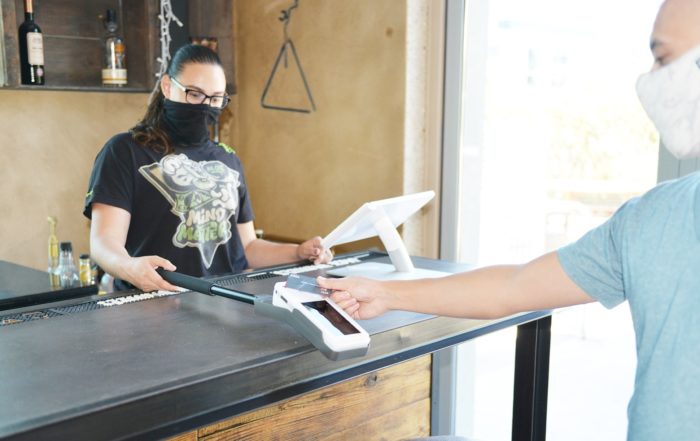Understanding the different factors that affect credit card payment processing time is important for any business. Join us as we explore these various factors and define exactly what is involved in the payment processing flow, from the customer to the merchant, and every step in between.
From the consumer’s perspective, the transaction process is fairly simple and takes just a few moments from start to finish. However, behind the scenes and from the business’ perspective, things are much more complex. Payment processing systems are designed to keep things simple on the surface, but there are many layers of technology and security at work each time a credit or debit card gets swiped or tapped. Unseen by the customer, there are multiple stops along the path of a single transaction, each serving an essential purpose.
All of these individual points involve a different combination of inputs and authorizations to successfully complete the transaction, and as such, each point can take a different amount of time. So, although the steps in the process that directly involve the customer may only take a few short seconds, the entire process may take significantly longer on the back end once all the necessary processing tasks have been completed. Let’s break down the payment process in more detail, and look at each of the various steps involved.
What Happens During the Payment Process?
The payment process begins the moment that the customer has finalized their shopping selections and is ready to complete their purchase. However, before we go any further, we feel it’s important to note that although the customer experience of shopping in a physical retail store is vastly different from what it’s like to purchase from an online e-commerce shop, the actual process of authorizing and completing the credit card or debit card transaction is very similar. Whether or not the transaction takes place at a physical POS terminal, or through a virtual online payment portal, all the same authorizations and verifications must occur.
The actual payment processing flow can be broken into two main stages; the Authorization stage and the Settlement stage.
The Authorization Stage
The authorization stage begins when the customer is ready to enter their payment method information. purchasing in person, this is done using a physical payment card with a swipe, chip and PIN, or tap on a contactless payment terminal. For an online e-commerce purchase, this begins when the customer has finalized the contents of their shopping cart and chooses to move to the payment entry step.
In all cases, whether from an in-store payment terminal, a mobile credit or debit card reader, or an online payment portal, the data is transmitted via a payment gateway to encrypt and secure the information as it moves from the merchant to the payment processor. The payment processor then communicates directly with the customer’s bank to verify the availability of the correct amount of credit or account funds to cover the value of the transaction. If the answer to the funds/credit inquiry comes back as an affirmative, the payment processor will reply to the merchant with approval that the sale has been confirmed. The customer will then be issued a receipt and they can happily walk away with their purchase. Of course, if the funds or credit are indicated by the bank as not available, the payment processor replies accordingly back to the merchant with a decline. At this point, the transaction process would need to be re-initiated with an alternate payment method.
The Settlement Stage
Once the merchant, the payment processor, and the customers’ bank systems are all in agreement that the transaction has been approved, the authorization stage concludes and the settlement stage begins. With the transaction verified, the customers’ bank or credit card issuer will then transfer the funds from the customers’ account over to the merchants’ account and subtract all the applicable fees that are due to the different business entities involved in facilitating the transaction. This may include bank fees, payment processing fees, credit card processing charges, and any other charges or membership fees that are required to be paid out in compensation for enabling credit and debit card transactions to occur.
In most cases, these transfers are processed in batches at the end of each day when the merchant digitally submits each verified transaction to the different banks and payment processors that were involved in approving each purchase. Once the settlement stage has occurred, the funds have been moved from the customers’ account over to the merchants’ account, and the entire payment process is officially completed.
How Long Does It Take to Process Credit Card Payments?
The exact timeline of processing a single transaction can vary depending on the type of payment and the number of verifications needed to authorize the payment. However, the initial authorization stage typically takes just a few seconds to run its course. Sometimes, with the most modern POS systems with fast communications, it may appear to be virtually instantaneous.
The settlement stage, on the other hand, can take anywhere from 24hrs to 72hrs from beginning to end. This is largely determined by the policies of the financial institutions, such as whether or not they are required to or choose to hold customer funds for a period of time before releasing them to the merchant, as an example. This kind of funds withholding usually serves as yet another security measure against transaction fraud and provides a bit of reassurance to the customer in case there is some issue or problem with their transaction.
Basically, in a nutshell, online banking payment processing time can officially be anywhere from 24hrs up to 3 days in some cases, but in the grand scheme of things this timeline is largely irrelevant to the experience of customers at the time when they make their purchases. Credit card processing transaction time really only affects the speed at which the funds arrive into the merchant accounts, and the customer has no actual involvement during this stage. Since the time required to transfer funds is more or less controlled by the banks themselves, there’s not anything a business can do to speed things along in this regard.
What Can I Do To Speed Up the Checkout Experience for My Customers?
Even though there aren’t many ways to speed up the actual fund transfers to reduce credit card transaction processing time, there are several things you can do in your business to speed up the checkout experience for your customers. Speed enhancements to the point-of-sale experience can drive up customer satisfaction, increase operational efficiencies, and even attract more business by offering the ability for customers to make purchases using their preferred method of payment, whatever it might be.
Checkout speed is heavily influenced by the number of steps involved. Cash is the slowest, as the customer must manually select the cash, hand it to the merchant, change must be calculated and counted out, and returned to the customer. Cards naturally make this process faster, but not all card types are equal, with some technologies providing a faster checkout than others. Swipe cards are faster than cash, but need a signature or PIN entry. Chip cards are faster than swiping, but also require a manual PIN entry to finalize the transaction.
Contactless or tap-to-pay systems are faster still, and condense the customer payment process into a single step. In addition to being the fastest checkout method, contactless payments are also the most secure, as each individual tap is encoded and unique, making transactions impossible to fraudulently simulate. Any business would be wise to invest in an up-to-date contactless POS system that provides the highest levels of security and checkout speed for their customers, as the effects on the customer experience are clearly very beneficial.
One other important aspect to consider is regarding internet communications speed. This is often overlooked or undervalued by companies attempting to save money on overhead costs by opting for a slower, cheaper internet service. The unfortunate reality is that slow internet can be a major source of customer frustration, as well as for employees, as long waits for payment authorization responses or dropped connections can seriously detract from customer satisfaction levels.
Choose the Right Payment Processing Partner for Your Business
Optimizing the checkout and transaction process should be a key strategy for your business, and this is made easier for you by choosing the right payment processing partner. To equip your business for long-term success and profitability, you need a merchant services provider that not only offers a complete range of payment technology solutions, but also brings top-tier support along with all the tools and resources you need to deliver the smoothest, fastest, and most secure transaction experience for customers.
By choosing MONEXgroup as your partner, you’ll be able to leverage the most advanced payment processing solutions and gain 24/7/365 access to our best-in-class customer support team and technical experts. If you’re ready to move your business forward, contact the team here at MONEXgroup today to learn more about how we can accelerate your success.
 Author: Layal Scheirich, Head of Sales at MONEXgroup
Author: Layal Scheirich, Head of Sales at MONEXgroup
Bio: With 18 years of experience in payment processing and merchant services, Layal has seen in-store POS technology evolve from its humble beginnings to contactless, unattended, mobile and online alternatives. Today, Layal is an inspiration to the MONEXgroup’s team and a go-to source of information related to payment processing. She is enthusiastic to share her knowledge with audiences interested in cutting-edge technologies available today, such as unattended payment for self-serve kiosks, e-commerce online payment gateways, virtual terminals, and contactless and mobile payment solutions.
Social Media Profile: LinkedIn
Contact Info: insights@monexgroup.com
Jumpstart your business potential now with MONEXgroup
Get a Free Quote
MONEXgroup Insights
MONEXgroup Insights provides all the tools and resources you need to start, run and grow your business.
The Future of EV Charging Payment Solutions
Adoption of electric vehicles in Canada is growing, partly due to the ever-growing importance of eco-friendly solutions across all aspects of life, but also because access to EV charging stations is rapidly increasing. Another
Secure Healthcare Payment Processing & Medical Payment Data Security
The protection of sensitive information is certainly a major concern for businesses of all types, but in the medical and healthcare industry it is absolutely critical. Companies involved in healthcare must invest in the necessary
Contactless Payment Systems vs. Mobile Payment Technology: What Are They and How Can They Benefit Your Business?
In the last several years, the use of contactless payment systems and mobile payment technology has skyrocketed. With the arrival of COVID-19 in 2020, that use has continued to grow, as businesses and customers



